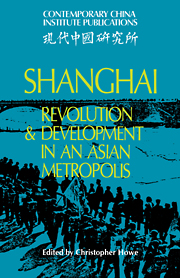Book contents
- Frontmatter
- Contents
- List of illustrations
- Preface
- Foreword
- Abbreviations
- PART ONE THE MODERN HISTORICAL PERSPECTIVE
- PART TWO POLITICAL LIFE
- PART THREE ECONOMIC DEVELOPMENT AND LIVING-STANDARDS
- PART FOUR THE SUBURBAN TRANSFORMATION
- 9 Shanghai–suburb relations, 1949–1966
- 10 The spatial development of Shanghai
- PART FIVE CULTURE AND IDEOLOGY
- Notes
- A chronology of modern Shanghai, 1842–1979
- Contributors
- Index
9 - Shanghai–suburb relations, 1949–1966
Published online by Cambridge University Press: 14 October 2009
- Frontmatter
- Contents
- List of illustrations
- Preface
- Foreword
- Abbreviations
- PART ONE THE MODERN HISTORICAL PERSPECTIVE
- PART TWO POLITICAL LIFE
- PART THREE ECONOMIC DEVELOPMENT AND LIVING-STANDARDS
- PART FOUR THE SUBURBAN TRANSFORMATION
- 9 Shanghai–suburb relations, 1949–1966
- 10 The spatial development of Shanghai
- PART FIVE CULTURE AND IDEOLOGY
- Notes
- A chronology of modern Shanghai, 1842–1979
- Contributors
- Index
Summary
Shanghai is China's largest ‘city’. The meaning of this fact is less evident, and may be more interesting, than it first seems. Social scientists often distinguish ‘urban’ areas from ‘rural’ ones; but they run into problems, because many social processes obviously cross the line. In traditional times, walls made the division clear. Modern, developed cities have torn down their walls in favour of wide suburban streets, which link grey and green areas instead of dividing them.
Gideon Sjoberg refers with splendid disdain to ‘city-limit sociology’. The problem with an emphasis on urban boundaries is that it obscures as much as it illuminates about the complex webs of human activity that centre on cities, but also spread out far from them. Around Shanghai, for example, there is a belt of ten rural counties, called ‘suburbs’ (shih-chiao). They are included in the political jurisdiction of Shanghai municipality, which is a province-level unit in the Chinese administrative system. It may be argued that these suburbs are essentially ‘rural’, or that they are essentially ‘urban’, or that they are something in between. In fact, their economic functions are thoroughly mixed between agriculture and industry. This is a region that grows largely industrial crops and vegetables for city use, in economic units whose mode of organization resembles a factory as much as it resembles most farms. In comparison with more truly rural areas, this region uses more fertilizer, has larger commercial accounting units, sends more family members to work in city factories, and has an atypically modern communications system – and political style.
- Type
- Chapter
- Information
- ShanghaiRevolution and Development in an Asian Metropolis, pp. 241 - 268Publisher: Cambridge University PressPrint publication year: 1981

